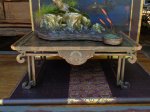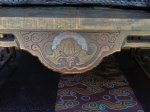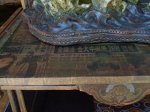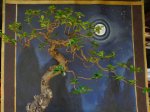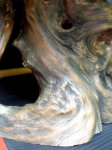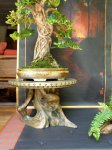In the course of things searching for the illusive and yet ubiquitous American Bonsai, the quest is could ultimately culminate in something that is so far away from Japanese sensibilities of Bonsai that it probably will not be understood as bonsai at all, but some totally different art form. Personally I believe, for the most part, you are going to see American bonsai with Japanese Cliches presented in American ways with American themes, characters, and methods of displays. I believe these presentations could be looked upon as parodies, not imitations.
A few times when this issues comes up for me is at a show or workshop. Super refined dense pads are the Japanese order of the day. In my opinion sometimes those images seem to manufactured. So I have a dream of keeping the wild look of a great piece of yamadori. Often it seems like a master or judge wants the tame version of over manufactured.
I don't want this to be about a lazy American not doing it right by Japanese standards. I want my tree to look like it just came down off a mountain. This is part of an American aesthetic.
The displays that sawgrass has shown here actually represent an aspect of American culture. To be honest, I'm not a fan. Simplicity is replaced with busyness. It's all good stuff visually, but it lacks the simplicity that I personally love. I'm apt to have two well-placed works of art in my living room. Simple, plain, profound. It's my personal style that goes into my trees. Some of an American style is the allowance for variety. It's generally not allowed... Too bad.
Sorry for lumping both of your replies together, I just think they both hit some if the same tones...
In my own personal view, I see nothing wrong with a display being very simple, often I think that yes, less is more... so, I am in no way shape or form against simplicity. The displays I did for these two trees is not necessarily a vision of what is to come from here on out with my work. I just did what I thought made the best design. Does it mean that I have to display every tree I display in such a way, of course not... as an Artist, I would like to think I am not a one trick pony, and in fact I strive not to be... I will always be searching for something new and different that I have not done before, so I can grow... but, if I do create another piece that resmbles these than in my opinion, that should not be a problem.
What I really liked about these, which as I have said before I didn't set out to do, but clearly they do... is they ask the question of what is possible, as well as show perhaps where bonsai can go. Does this mean they are for everone... or that everyone has to design a display in such a way? Of course not... Everyone should be entitled to do what they think is best and right, as well as what they like... I hold no objections to someone doing this, and frankly find it odd that others do? This is why time after time when someone says you can't do something, or that something can only be a certain way, I will always hold objection to this kind of view, because it is in my opinion, rubbish. Do what you want to do...
Now, with that said. .. want to touch basis on the view of American trees being less refined, and how we should all hold our standards to that of the Japanese, when judging our work...
I was going to start a different thread about this, because I really think it is worth examining...
I have heard time after time, how work that is not Japanese, is not good... how so? I would have to totally disagree with this notion... Why? Because I don't think that one can compare the two... they are just different, and if one looks you can often see that the Artist who create the work seek perfection in different ways.
Will give an example... Chinese Penjing is looked down upon often because many feel that it lacks the discipline that Japanese work does... to put it blunt, the lack of refinement. However, if one examines work done by the Chinese, there is discipline in areas the Japanese lack, due to what each culture holds dear about the Art.
To the Chinese, the art is all about the storytelling, and funny enough about simplicity in their trees . ... go figure, right? This is what is important to them, so it is not uncommon to see their trees with very little ramification, in fact most is actually removed. Like I did with my Fuikien Tea. .. I have gone through and actually removed half if not more of the branching due to the notion, that what was important, was showing a sense of the tree feeling Airy, as well as the notion that often with very old trees you will find they have very little branching and are just hanging on, which is what old trees in nature actually do. They started the art, with the sole purpose of trying to depict what it was they were seeing happen in nature in their neck of the woods. Now obviously, there has been some embellishments along the way, as they sought to try and also stir a sense of mysticism into the work, for in their culture ancient trees held great power and we're often thought to be either blessed or cursed individuals, or even gods, who had returned to earth to now live out their lives in such a way.
Then the Japanese borrowed the Art, changed the name, and added their touches and their trees became reflective of what was important to them... So, the importance of the story of the tree, was lost somewhat in favor of just the perfection of the tree and the Art. You will also note, that the trees actually became less about being subtle, which here again is funny, due to the fact that most associate Japanese culture with being subtle... and in fact did the complete opposite. .. they became quite complex, and to be totally honest, they really inserted their ego within their work to show their craftsmanship of what they could do over nature, rather than what actually nature is... I know... bizarre isn't it... who would of thought that the Japanese could be so egotistical? They added tons of branching and ramification to show the Artist's "skill", in their quest for perfection. But, as we all know nature is not perfect... it just is. And now in places like Tiawan, they have even upted the scale and taken this vision even further.
Both, in my opinion are great, yet at the same time are totally different... Not, quite sure how someone could even begin to try and compare the two as far as which are better? Seeing that they both hold totally different values as to what is important, and what it is that the Artist seeks to accomplish, but hey... that is just me...
My view of perhaps where in the end the American Bonsai Scene might fall is perhaps somewhere in the middle of the two? You have folks who strive to be more natural, and suprisingly enough a lot like the Chinese, who sought to try and replicate what it is that they see in nature... and folks who like all the ramification, due to the notion that this is what has somehow now comes to define what a good tree must be. To me this is fine...
How's that for someone who claims to not actually know these cultures...


